FAQ
-
What are heat pumps?
Heat pumps are efficient electric devices that heat and cool your home by moving heat instead of creating it. They use 2-4 times less energy than gas appliances, saving money and cutting pollution.
-
Will I need to upgrade my electrical panel?
Probably not. Your electrical panel (the breaker box in your home) distributes electricity to different appliances and rooms. Most Bay Area homes won't need a panel upgrade to install a new heat pump water heater or furnace. Here's why:
Most homes have plenty of capacity: Research in PG&E territory found that 71% of homes with smaller panels have more than half their electrical panel capacity still available to power additional appliances.
Real homes prove it works: A study of thousands of all-electric homes found that 99% never exceeded 100 Amps — well within the capacity of standard electrical panels.
Plus, many heat pump water heaters simplify installation: New models plug directly into a standard wall outlet, avoiding the need for any new electrical wiring at all.
The bottom line: Your existing electrical panel can very likely handle the switch. And if you're among the small percentage who do need upgrades, available rebates can help cover the costs. -
What about power outages?
It's true that heat pumps need electricity — but so do most modern gas appliances, which have controls that won't work during outages either.
For households concerned about longer outages, home battery storage systems (often paired with solar panels) can keep your entire home running.
And some modern electric appliances have advantages during power outages: heat pump water heaters store hot water in well-insulated tanks that keep the water hot for hours or even days after the power goes out. -
Can I get help with costs?
Yes! State and local incentives are available, totaling over $4,000 in some cases. And for low-income households or homes with installation challenges, flexibility measures are being developed to ensure no one is left behind in this transition.
-
What if my water heater breaks?
New plug-in heat pump water heaters can be quickly installed using standard outlets. Same-day or 48 hour replacements are becoming widely available across the Bay Area.
-
How can I find contractors and support services?
These services can connect you with vetted contractors, help you understand available incentives, and even guide you through your upgrade plan — all for free:
QuitCarbon – A free, nonprofit service that helps Bay Area residents plan their home electrification journey and connect with trusted local contractors.
Switch Is On – California’s statewide hub for rebates, certified installers, and educational resources on electric upgrades.
-
Do we have enough power grid capacity?
Yes. Heat pumps actually help the grid by using less energy and connecting to smart systems that reduce strain during peak hours.
-
Do these standards apply to my kitchen stove or cooking appliances?
No, these particular standards only regulate outdoor air pollution from heating and water equipment (i.e. gas furnaces, water heaters). The Air District doesn’t have authority over indoor cooking appliances. However, gas stoves do emit nitrogen dioxide and other pollutants that can worsen indoor air quality — especially without strong ventilation. For that reason, many advocates recommend switching to electric induction cooktops, which produce zero combustion emissions indoors.
